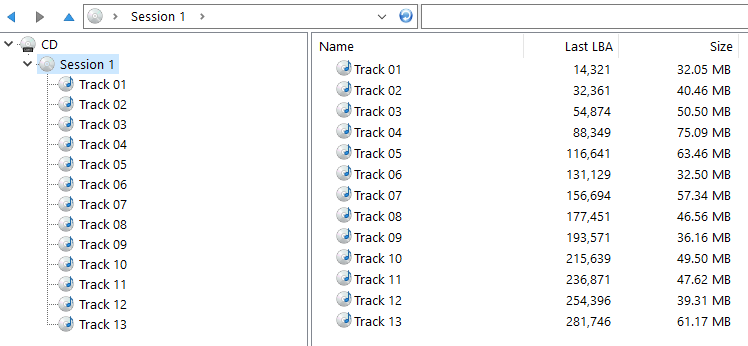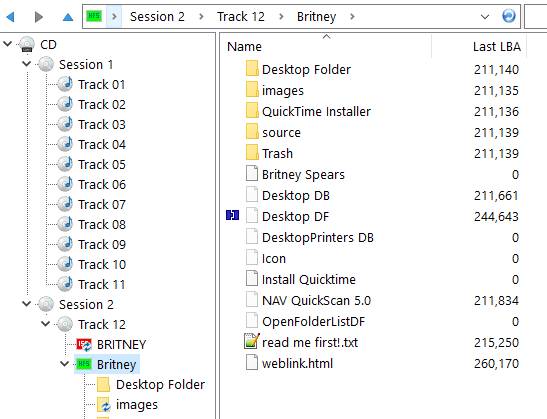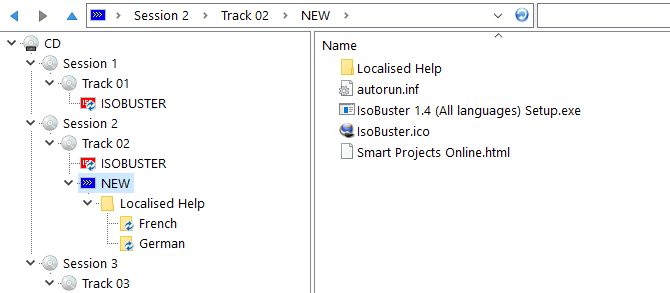CD/DVD Layout
A CD or DVD contains pits and lands in a groove. And when a laser reads over these pits and lands (while following the groove) a high frequency signal is created. From this high frequency signal logical 0 (zeroes) and 1 (ones) can be derived (through Analog to Digital circuitry). Pits and lands are terms used to originally indicate a height difference (e.g. a pit is low and land is high) however pits and lands can also mean a reflectivity difference (e.g. RW), so the height is the same but the reflectivity is different and so again logical 0 (zeroes) and 1 (ones) can be derived from the resulting high frequency signal.
The resulting binary data (zeroes and ones) is then mangled through several decoding mechanisms, each time cutting off the error correction and household data (Level 1 and 2 error correction in case of CD). The data is also de-interleaved and put together in addressable physical blocks in different areas. Areas like the lead-in, the program area, the lead-out etc.
While physical addresses are being used internally by the optical device (CD/DVD-ROM drive) a host (OS, application, ...) will be able to address logical blocks. Logical blocks can but do not necessarily match with the physical blocks. There are several addressing methods (methods 1, 2 and 3) and they allow a drive to 'hide' physical sectors which a host doesn't need to see. E.g. run-in, link and run-out blocks in case of packet writing, spare areas in case of Mount Rainier etc. ...
Every block which is made up of 2352 bytes can contain data in different modes. E.g. an Audio block contains 2352 bytes of audio data. A Mode 1 Data block contains 2048 bytes of user data. The remainder of the 2352 bytes was used to do third layer error correction and so on.
A continuous non-interrupted, in ascending order addressable, set of logical blocks of which the start address is recorded in the TOC (or DVD structures) is called a track. A CD or DVD contains one or more tracks and a track is always located in a session. So in fact the most simple CD or DVD layout is a disc containing one session with one track. Tracks are made up from blocks which were mastered or recorded in different modes but basically you can distinguish two different kinds of tracks. Audio tracks and Data tracks. Audio tracks are always mastered or recorded in one mode : Audio. Data tracks can be recorded in the 2 modes 1 or 2 and in case of 2, different Forms are possible as well.
A session can contain one or more tracks. When a session is finalized, a TOC (or DVD structure) is recorded in the lead-in of that particular session. So every session has it's own TOC containing the layout of the session and the layout of the previous sessions. A CD/DVD-ROM drive will always look for the highest session and will find the layout in the lead-in of the last session. Audio copy protections often rely on the fact that standard audio players only look in the first lead-in to find the audio tracks in the first session. A CD/DVD-ROM drive however looks in the highest session lead-in and that's where sometimes incorrect data is stored about the first audio tracks so that they become inaccessible. A first session's lead-in is not addressable. Lead-in and Lead-outs of the higher sessions are located in the program area and are addressable but mostly not accessible by the host.
Then finally, now Blocks, Tracks and Sessions are understood ... a higher level order is the combination of tracks and sessions.
An Audio CD contains a set of audio tracks in the first session. The Audio CD standard (Red book) describes audio in the first session only.

A CD-Extra or Enhanced CD contains a combination of audio tracks and data tracks so that standard audio players can play the audio tracks (as they only bother about the first session). CD/DVD-ROM players report all the tracks, including the data track(s) in the second session and that's where an operating system will look for File-Systems.

Another variant used to combine Audio with Data is the so called Mixed Mode CDs. They contain both audio and data tracks in the first session. The first track is a data track (where the Operating system will look for File System) the remaining tracks are audio tracks. A standard audio player of today will skip the first data track and proceed with the audio tracks, older audio players could get into problems trying to play the data tracks (Hence the use of Enhanced CD).
Multi-Session Data CD/DVD
Recording data CDs has become an every day thing and many people own a CD and/or DVD writer. Since the media can often contain more data than it is used for while recording the option was created to add more sessions. Every session contains its own File-Systems pointing to the different files and folders. The strategy of the File-Systems on Multi-Session CDs is explained in File Systems.
